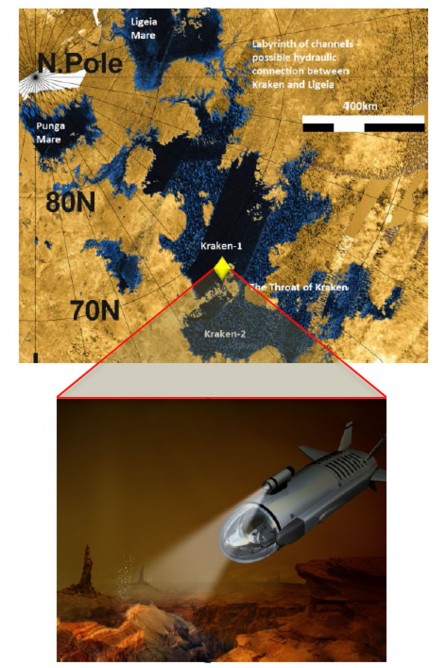
NASA has given us a first look at the space submarines they might use to
explore Saturn's largest, sea-covered moon, Titan. We're excited.
The US space agency is on a roll lately. Just last week, it announced it was allocating funds to a mission to explore Europa, Jupiter's water-laden moon. And at the end of last year, it announced it was sending humans (humans!!) to Mars.
Now we have been given a glimpse into the robotic submarines that NASA might use to explore the liquid hydrocarbon seas of Titan, Saturn's largest moon. And they might be launching them into space as early as 2040.
The US space agency is on a roll lately. Just last week, it announced it was allocating funds to a mission to explore Europa, Jupiter's water-laden moon. And at the end of last year, it announced it was sending humans (humans!!) to Mars.
Now we have been given a glimpse into the robotic submarines that NASA might use to explore the liquid hydrocarbon seas of Titan, Saturn's largest moon. And they might be launching them into space as early as 2040.
At the 2015 NASA Institute for Advanced Concepts
(NIAC) Symposium in Florida, a group of NASA engineers and scientists
presented a conceptual design of the unmanned submarines that might be
used to explore the moon, as David Szondy reported for Gizmag. Spoiler - it looks pretty cool, as you can see below.
As far as moons go, Titan is a bit of an oddity. To start with, it's
HUGE. So big, in fact, that it's larger than Mercury, and it has its own
proper atmosphere, which is made up mostly of highly pressurised
nitrogen and methane. It's also pretty cold, at a temperature of around
-179 °C.
But perhaps most interestingly is the fact that surrounding Titan's poles are three seas, filled with liquid methane and ethane, as flybys by the spacecrafts Voyager and Cassini have confirmed. The largest of these seas is Kraken Mare,
which covers 400,000 square kilometres and is estimated to be up to 160
metres deep. However, some calculations put it at nearly twice that
depth.
Because of Saturn's gravitational pull, Kraken Mare also
has tides, as well as a shoreline and evaporite deposits, which makes it
particularly interesting to scientists.
And that's where the
submarines come in. In this design, the models would be around 1 tonne,
and would be powered by a 1 kW radiothermal Stirling generator, allowing
it to travel at around one metre per second.
After being dropped
off by a winged spacecraft, the submarine would slam down onto the
surface of Kraken Mare at hypersonic speeds, before diving down to being
its 90-day mission.
In
order to communicate with Earth, the submarine would emerge for around
16 hours each day, during which time a mast camera will be used to
monitor its surroundings - including, hopefully, some pretty spectacular
views of Saturn.
But, of course, there are plenty of issues with
driving a submarine on an extraterrestiral moon. For starters, the
excess heat produced by the generator would boil the liquid gas around
the submarine. It will also take some more research to work out how a
craft would float in a sea of gas, and how the craft would be able to
balance and propel itself safely.
As the authors of the report conclude:
"This study is only the first cut at a design, and has identified a
number of technical trades and areas deserving closer study. Even with
its planetary application aside, this exercise has forced us to look at
submarine vehicle design drivers in a whole new way."
The report
is pretty tight-lipped about the objectives of the mission, but we think
that any mission heading out to explore extraterrestrial seas is pretty
exciting. Analysing the organic chemicals on Titan might also help us
understand more about how life began on Earth.
Now we really want to know what the submarins that will explore the ocean-covered moon Europa will look like. Bring on the era of extraterrestrial ocean exploration.
Source: Gizmag

No comments:
Post a Comment